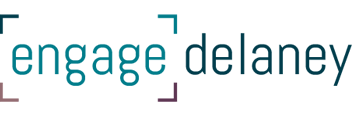2024 Engagement Forecast
Every year, I do an engagement forecast. It’s a look forward that is informed by looking backward, looking beyond my own engagement context, and reflecting on engagement with a hot cup of tea and candle burning. With a look ahead to 2024, here are five big trends in the annual Engage Delaney engagement forecast.
- Deeper stakeholder, partner, and interested party engagement: With long-term planning initiatives, be it strategic plans, community official plans, transportation plans, waste management plans, and others, I believe that bringing core parties together to deeply collaborate on idea generation and option assessment will be even more of a priority in 2024.Going broadly to engage the public has its place, but often, the public is better positioned to respond to ideas. This may mean different, more collaborative engagement methods to bring people together to solve challenging problems. I believe that study circles, summits, working groups, and highly participatory processes with smaller groups are going to be on the rise in 2024!
- Climate change intersecting everywhere: Given the rise of climate-related emergencies and a real thirst for change amongst Canadians of all ages, locations, and backgrounds, I believe there will be increasing focus on how climate change intersects with each project and in each process. Looking at how we engage, and the associated impact of our engagements from climate and carbon perspectives will also be under the microscope. Not only do I see an increase in dialogue around climate change in the “content” of the engagement, but I see a real look at the “process” and what impacts it has on the climate emergency. Beyond costs, I believe there will be even less appetite for flying people to engagement sessions or having resource-intense materials at conferences.
- Social justice and equity: Projects and processes will be increasingly evaluated by the degree to which they advance social justice and equity or reinforce systemic inequities. In 2024, I see more allies, supporters, and community groups being part of a movement to challenge system-wide inequities. What’s more, observers and participants alike will look to the engagement process itself to ask: was the process equitable? Did it reinforce existing power and privilege? How did the process support participants?
- AI: Friend or Foe? In 2024, I believe there will be increased research, experiential application, and experimentation with AI in engagement. Already it’s been used to capture notes, and some are using it to support qualitative analysis. The question of how AI can support engagement, planning, implementation, and reporting is still very much open, but I believe that by late 2024, we will have a better understanding of how it can reduce time and cost as well as the potential risks, recognizing that engagement is a human experience.
- Staff Engagement: Recruiting and retaining engagement and communications staff will remain an important organizational priority for employers. I believe that more and better employee engagement will play an important role in recruiting and retaining staff. This might mean engaging staff on the way they work (remote, in-person, hybrid), wellness and supports, professional development, organizational policies, or simply engaging staff prior to or after engaging the public or stakeholders. In the knowledge economy, quality staff are key to any successful organization, and engaging them is one key strategy to retaining them!
When you look ahead to 2024, what engagement trends do you see? I hope this has been a helpful forecast and wish you an engaging 2024.




